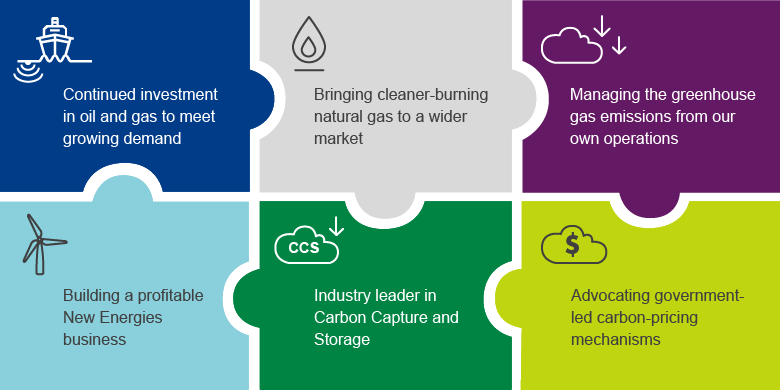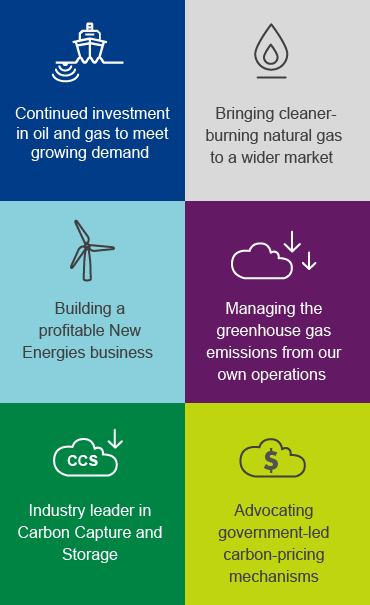Towards a low-carbon future
The energy transition will require providing much more energy to meet rising global demand, while at the same time significantly reducing carbon dioxide emissions.

Most of the world’s energy consumption comes from coal, oil and gas sources, but only around a fifth of energy consumption is electricity.
Energy is essential to the global economy. From fuels to fertilisers, and manufacturing to transportation, energy enables the lifestyles that many enjoy today. Access to reliable energy can transform lives and enables economic growth.
However, around 20% of the global population lives in OECD countries but uses 40% of the world’s energy. Billions of people still lack access to energy that many take for granted: modern, affordable energy for heating, lighting, cooking, refrigeration and sanitation.
The world’s primary energy demand, driven by a growing population and rising living standards, is expected to rise by 30% between 2015 and 2040, according to the main scenario in the International Energy Agency’s World Energy Outlook 2016. At the same time, there is a critical need to address environmental stresses, from local air pollution to climate change.
Today, oil and gas make up around half the world’s primary energy mix, and coal provides around 30%. The rest comes from sources such as hydropower, biofuels, solar, wind and nuclear. More energy from this current energy mix means more greenhouse gas emissions, which in turn leads to climate change.
The transition to a low-carbon future will unfold at different paces in different places, and across all sectors of economic activity – creating new risks and opportunities. New technologies, business models and partnerships, supported by policy and regulatory frameworks, will be needed.
Shell will play its role in a way that is commercially competitive as well as environmentally and socially responsible, in oil and gas, as well as in low-carbon and renewable energy sources. Our success depends on our ability to anticipate the types of energy that people will need.
Transforming the global economy
The Shell Scenarios publication, A Better Life with a Healthy Planet: Pathways to Net-Zero Emissions, sets out a plausible route for the world to achieve, during this century, economic development for most people coupled with net-zero greenhouse gas emissions from energy. In a net-zero world, emissions in some sectors are offset by efforts to remove carbon dioxide (CO2) from the atmosphere, including reforestation and large-scale industrial facilities built to capture and store CO2.
Making this transition will take significant efforts to boost energy efficiency. A transformation of the global economy is also required, especially in the power, transport, buildings and industry sectors, where a significant proportion of energy-related emissions of CO2 occurs.
The power sector, for example, must evolve into a combination of more renewable sources of energy, nuclear, and natural gas – the cleanest-burning hydrocarbon – with carbon capture and storage (CCS) technology. In the transport sector, passenger road travel increasingly needs to be electrified or to rely on hydrogen. For the foreseeable future, longer-distance freight shipping and aviation will continue to rely on energy-dense liquid fuels, including oil, biofuels and liquefied natural gas.
Looking beyond electricity
Increasing use of renewable sources of energy is essential for a transition to a low-carbon future. However, renewables are mainly used to produce electricity, which today only meets 18% of global energy demand. For renewables to have a bigger impact, electricity has to play a large part in other key sectors of the economy.
The switch to using electricity powered by low-carbon or renewable sources will be easier for some sectors, such as the manufacture of clothes and food, which require relatively low temperatures.
Other sectors, such as industries that produce iron, steel, cement, plastics and chemicals, rely on hydrocarbons to provide extremely high temperatures, chemical reactions or dense energy storage. Many of these cannot be electrified at all, or only at a high cost. In the transport sector, oil currently supports more than 90% of demand. In the coming decades, passenger road travel will increasingly need to be electrified, powered by batteries or hydrogen.
Petrochemicals, the building blocks of products people use every day, such as solvents, detergents and plastics, will also continue to play a vital role in meeting the demands of a growing population and in some cases can improve energy efficiency. Replacing metal car parts with lighter plastics, for example, helps lower fuel consumption and therefore reduces emissions.
Today’s energy needs
The world today currently consumes most of its energy from coal, oil and gas sources. Around a fifth of total energy consumption is electricity. Energy sources differ across the sectors of industry, transport, and domestic use which all need to transition to low-carbon energy options.
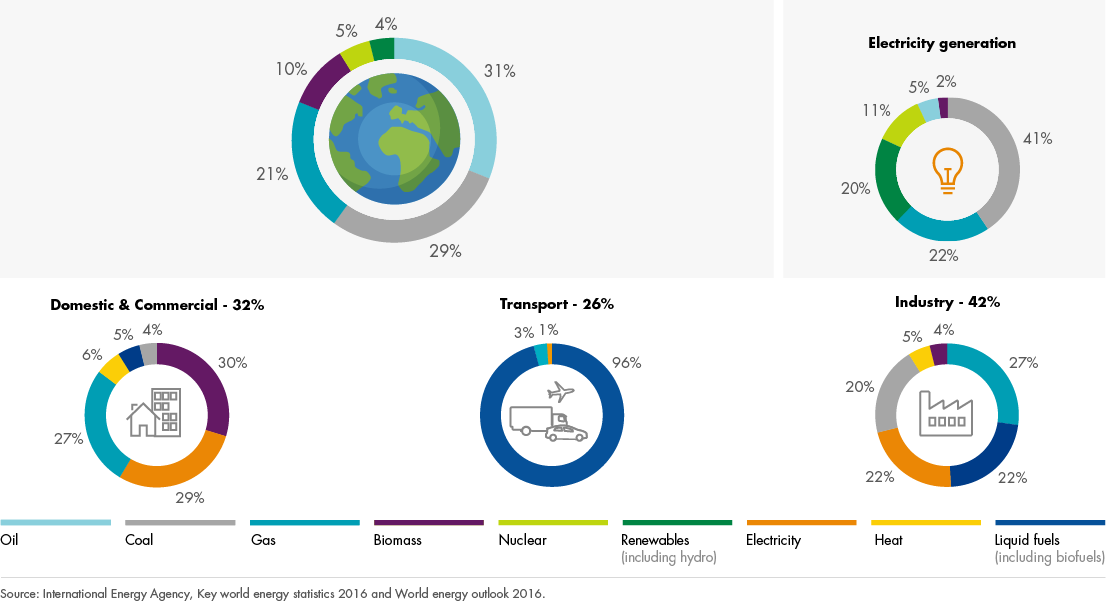
Current global energy demand
There are currently no easy replacements to fuel heavy industries, where extremely high process temperatures are required. Petrochemicals are the building blocks of thousands of products that people use daily.
Enlarge image
Domestic & commercial demand
The buildings sector is responsible for nearly one-third of global final energy consumption and is also the source of a large proportion of electricity demand and therefore emissions in the power sector. The primary use of energy in buildings is for heating or cooling, lighting and cooking.
Enlarge image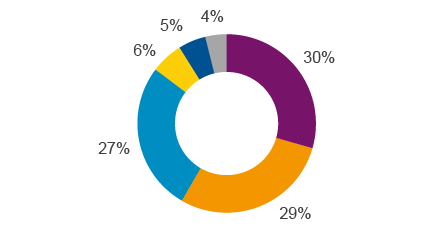
Industry demand
There are currently no easy replacements for hydrocarbons in energy intensive industries, such as in petrochemicals or in iron and steel manufacturing where extremely high temperatures need carbon-intensive processes.
Enlarge image
Transport demand
Oil currently powers more than 90% of transport, with aircraft, motor vehicles and ships in use for between 15 and 25 years.
Enlarge image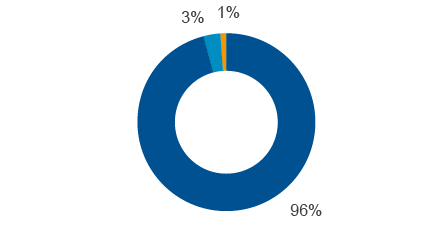
Electricity generation
The power sector transforms primary energy into the electricity used in other end-use sectors. Because electricity is emission-free at its point of use, the decarbonisation of the power sector can enable decarbonisation elsewhere.
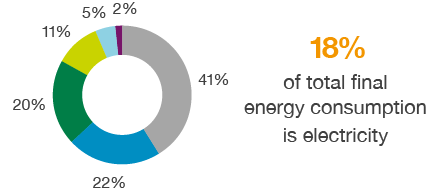
Securing a smooth transition
The transformation to a low-carbon energy system requires urgent action. It will take realism, investment, innovation and collaboration between policymakers, business executives, non-governmental organisations and energy consumers.
Government-led carbon pricing mechanisms are one essential policy tool that can drive efficiencies and provide an incentive for lower-carbon choices by businesses and consumers.
Other policies should focus on city and transport planning to improve energy efficiency; accelerating the switch from coal to gas to reduce power-sector emissions; sustaining the rapid growth of renewables; and establishing the widespread use of CCS, which can significantly reduce emissions from industrial sectors by safely storing CO2 deep underground.
Energy challenge
There is more demand for energy globally as the world's population and living standards increase.

Energy transition
A successful energy transition requires substantial investment across all energy sources, including oil and gas production, to meet growing demand for energy.
Growing population
Global population will increase from around 7.4 billion today to nearly 10 billion by 2050, with 67% living in cities.
Rising demand
Global energy demand will likely be almost 60% higher in 2060 than today, with 2 billion vehicles on the road (800 million today).
Ongoing supply
Renewable energy could triple by 2050, but we will still need large amounts of oil and gas to provide the full range of energy products we need.
Mitigating climate change
Net-zero emissions is a potentially achievable societal ambition.
Towards a low-carbon future
Shell is working to meet the energy challenge in many different ways:




